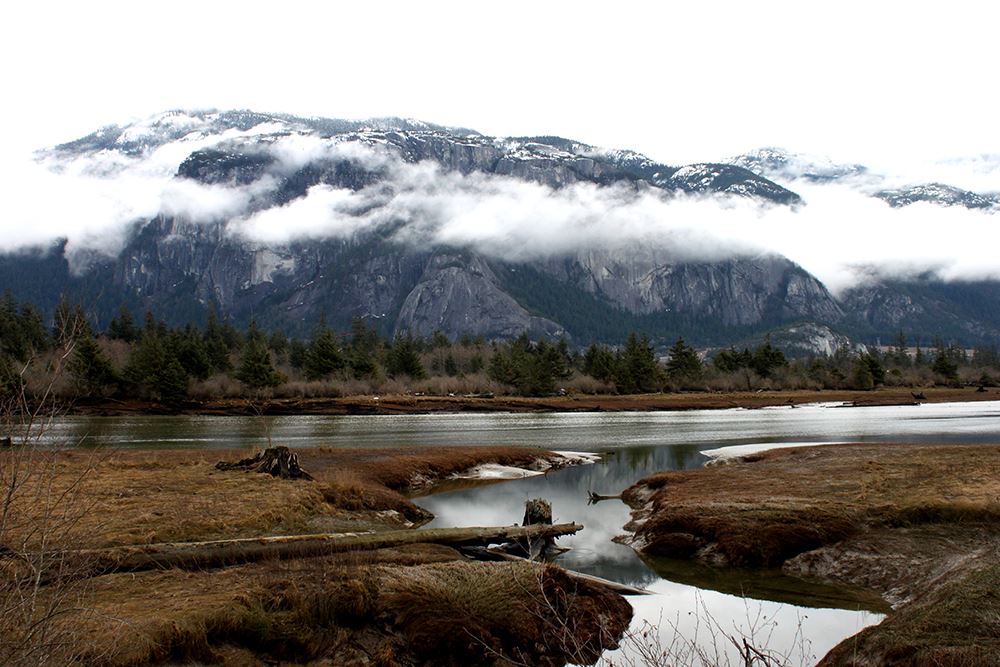Wisdom from the land
November 27, 2024

Siy'ám' Smánit. Photo courtesy of Nadine Ryan.
Grounding yourself is a daily routine. It's a practice based on seeing the world as it is. . . . We have a beautiful Mother Earth who, with every season, gives us gifts and new things to marvel at.
- Katsi'tsakwas Ellen Gabriel (When the Pine Needles Fall: Indigenous Acts of Resistance (Toronto: Between the Lines, 2024, 1).
The IEA began as a volunteer-run organization and has grown to include paid professionals working alongside dedicated volunteers to strengthen the structures and plan for the future. This is meaningful work, yet it has its challenges: the IEA's small team has been overstretched and capacity has been limited. But these challenges have also sparked conversations around the organization's continuity and sustainability and questions about our relationships with time, labour, community, culture, bodies, and Land.
Moving away from a settler-colonial culture of urgency and insatiable productivity, we are taking the opportunity to create another pathway, one that centres Indigenous worldviews and values, guided by the natural world and its rhythms. We hope to set an example by enacting ways of working together that are informed by the principles of reciprocity, respect, responsibility, holism, interrelatedness, and collaboration. As we ground ourselves in these intentions, we continuously reflect on what it means to work and grow an organization from Indigenous governance frameworks and Land-based wisdom. And we ask ourselves how this work may serve our team, membership, communities and lands. Below are a few practical ways we envision this work so far.
Gratitude for the Land
Expressing gratitude for the Land is a grounding and humbling practice; it's a chance to clear our minds, centre ourselves and remember that our thoughts, words, and actions have rippling effects. Like others, at the IEA we believe it's important to begin our gatherings and events with gratitude for the Land and to start each day in this way as well. Gratitude can be words spoken or written, or it may mean cleansing yourself with smudge, cedar, or salt water; going for a walk; sitting in a park; sipping tea; spending time with family; or any other activities that nourish you. You will be able to read our full Statement of Gratitude when the new web portal is launched in December 2024.
Seasonal activities and programs
Connecting with Land draws awareness to the natural cycles around us. Recognizing the Land as a teacher and guide, our operational and programming activities aim to reflect the seasons and honour our cultural and ceremonial periods. Because the IEA is based on xʷməθkʷəy̓əm, Sḵwx̱wú7mesh, and səlilwətaɬ territories, we are rooted in this region and extend out from here, inviting team and community members to observe the seasonal wisdom in their local areas.
Envisioning spring and summer as periods of renewal, resurgence and connectivity, our activities and programs during this period may include speaking engagements, educational and professional development events/programs, and gatherings-both in-person and virtual. As the natural world cools and quiets in the fall and winter, our activities honour this pace with focus on reflection, reorganization and regrouping and we recognize this as a good time for storytelling events/programs in the near future as well. During the late fall and early winter, our annual general meeting takes place-we can think of this as an end-of-harvest gathering.
Office closures and holidays
In addition to B.C.'s provincial holiday closures, the IEA offices will be closed on important Indigenous commemorative and awareness days, such as National Indigenous Peoples Day and Truth and Reconciliation Day, and we advocate that other organizations do the same. We also observe the annual solstice and equinox days as meeting-free days and offer staff the opportunity to attend cultural and ceremonial events. Beginning in December 2024, our annual calendar will be available on the new portal.
As we develop the IEA, we're working to imagine a different organizational structure, one that begins from a place of relationality and centres the importance of wellbeing and care and Indigenous narrative sovereignty. We are inspired by and advocate for culturally engaged and life-affirming work that allows for revitalization and honours and respects the Land that sustains us.
The blog posts that will be published over the next few weeks share wisdom from different First Nations, Inuit and Métis creatives about Land-based knowledges. The next post in the series is "We Are One" by Métis author Paul Chaput. Paul uses a mix of poetry and prose to talk about the differences between Indigenous and Western ways of working and using the land.
In "Inuit Seasonal Activities," Inuk writer Napatsi Folger talks about the ways that the four seasons we expect in southern Canada are insufficient for Inuit activities based on cycles of harvesting, which change depending on climate and weather.
Haíɫzaqv author Jess Housty uses the life-cycle of fireweed to show us the "rhythm of seasonality and the reciprocal joy of shared abundance." She likens that life-cycle to how she lives throughout the year.
The final post is by Mi'kmaw writer Lisa Frenette. Lisa talks about finding balance while living in a large city by using Two-Eyed Seeing, a teaching from Mi'kmaw Elder Albert Marshall that balances Indigenous and Western ways of knowing.
Author Bio
Nadine Ryan is a shíshálh and settler editor, writer, and visual artist from shíshálh and Sḵwx̱wú7mesh swiya (Sechelt and Squamish lands). Ryan created the IEA's Strengthening Creative Capacity project, which created the IEA's first staff positions and allowed the IEA to become a thriving and sustainable membership association. After serving as ED for two years, she is now active in the IEA's Projects & Programming Committee. Ryan enjoys freelance editing and writing projects, practicing photography, and walking as a mode of research. She is interested in exploring other ways of doing scholarship and arts administration; ways that are guided by Indigenous thinking and storytelling.